Not many coaches are afforded the opportunity to become the head coach of their national team. Far fewer are afforded that opportunity without prior experience as a head coach. However, that is the exact position that Robert Moreno found himself in as he took charge of the Spanish national team in March 2019.
The former long-time assistant of Luis Enrique was thrust into Spain’s head-coach position following Enrique’s resignation due to personal matters. The 42-year-old turned many heads in world football as he guided Spain to EURO 2020 qualification with an undefeated record.
Moreno was subsequently branded as “disloyal” by Enrique as a falling out between the pair led to Moreno’s resignation from the Spanish national team as Enrique reclaimed his position. However, Moreno’s impressive 77.78% win percentage didn’t go unnoticed. Just a month following his resignation from Spain, Moreno became the new head coach of Monaco.
The exciting young coach has made an immediate impact at Monaco. He has already impressively guided his new team to a 3-3 draw with PSG at Le Parc des Princes. Monaco’s Cesc Fabregas has spoken out in praise of his new coach stating that the Barcelona-schooled coach has brought “order and a style of play” to Les Monégasques.
In this tactical analysis, we will analyse some of the key aspects of Robert Moreno’s tactics. We will look at Moreno’s tactics with Spain, as well as the tactics deployed by Moreno in his first few games with his new club. This analysis will break down what Monaco fans can expect from their new head coach.
Positional fluidity
One of the key aspects to Moreno’s style of football thus far has been strong use of positional fluidity. This element of Moreno’s tactics had been clear throughout his tenure in charge of the Spanish national team. Even in the early days of his tenure at Monaco, it is clear that positional fluidity will likely continue to be a key part of Moreno’s tactics going forward.
In-possession, Moreno allows his players a large degree of positional fluidity. This allows his players to exercise a large amount of their freedom and creativity on the pitch. Throughout his Spain tenure, Moreno’s use of positional fluidity was particularly clear in three particular areas.
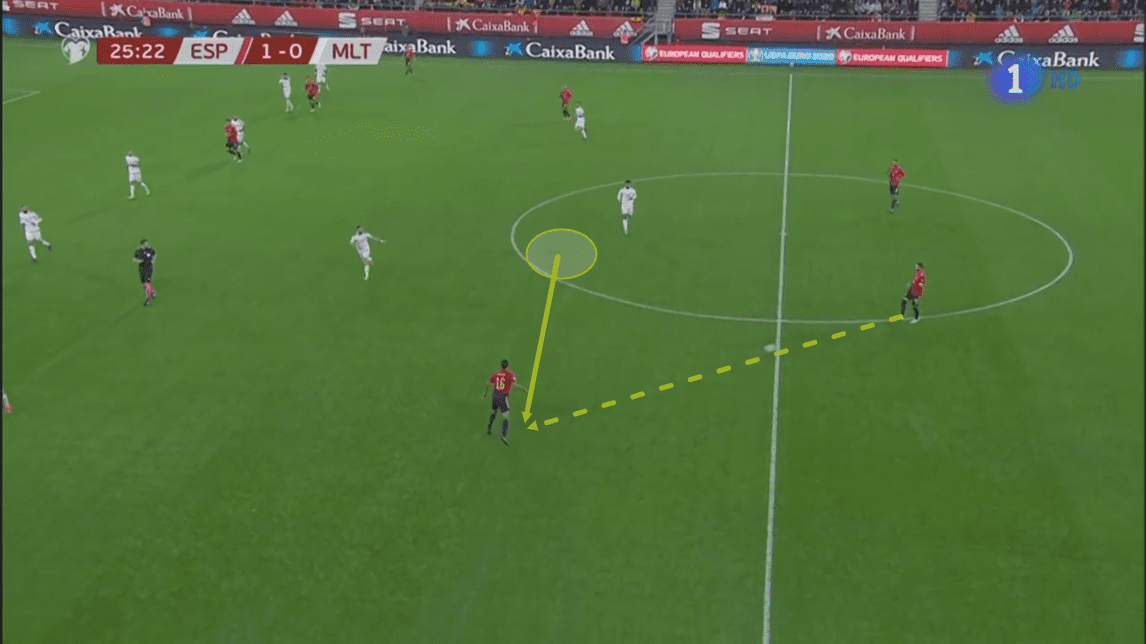
Firstly, during the build-up, Moreno’s central-midfielders often ended up occupying wide areas. We can see an example of this in the image above. This image shows us an example of Rodri, Spain’s holding midfielder, vacating his central position. Rodri shifts out wide in this passage of play in order to escape the press of Malta’s centre-forward.
This type of movement in the build-up was a common theme for Moreno’s holding midfielders at Spain. Moreno’s Spain would often vacate the central areas in the build-up in order to get around the opponent’s pressure.
As the midfielders received possession in space, they could then distribute the ball into more dangerous positions where Spain had deployed greater numbers out wide, as we can see on the right wing in this image.
Another way that Moreno’s Spain frequently utilised positional fluidity was the movement of the centre-forwards. We frequently saw Moreno’s centre-forwards make wide, outward runs from the centre of the pitch into crossing areas. These runs were effective at pulling opposition centre-backs out of position. This, in turn, created space for Spanish attackers to probe into and try to get onto the end of a cross.
Álvaro Morata could frequently be seen making these wide, outward runs during Moreno’s Spain tenure. As he received the ball while moving towards the edge of the box, he created space for Spanish midfielders and the opposite winger to move into the box. This was an effective tactic at creating chances for Spain during Moreno’s tenure.
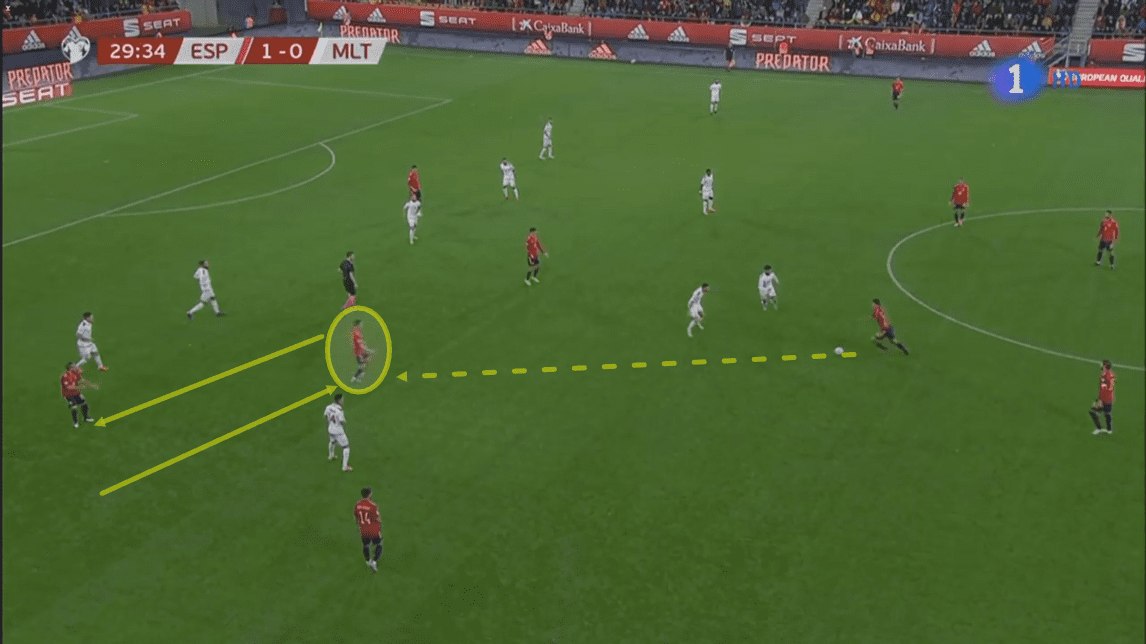
Lastly, the third most common example of positional fluidity from Moreno’s Spain was the interchange between the ‘8’s and the wingers. We can see an example of this in the image above. This image is captured just moments after Spanish ‘8’ Santi Cazorla has shifted out to the left wing. In doing so, he allows left-winger, Pablo Sarabia, to come narrow.
This kind of positional interchange was effective at creating space for players to receive the ball. This image shows us a clear example of this. As Sarabia shifts to the centre, he loses his marker, the Maltese right-back. He manages to find freedom in the half-space where he can receive a pass from Rodri. Sarabia is subsequently able to link-up with Morata and create a dangerous situation for Malta to have to deal with.
These examples show us the importance of positional fluidity in Moreno’s Spain. We believe that this is a key aspect of his tactics, which we are likely to see more and more of in his time at Monaco.
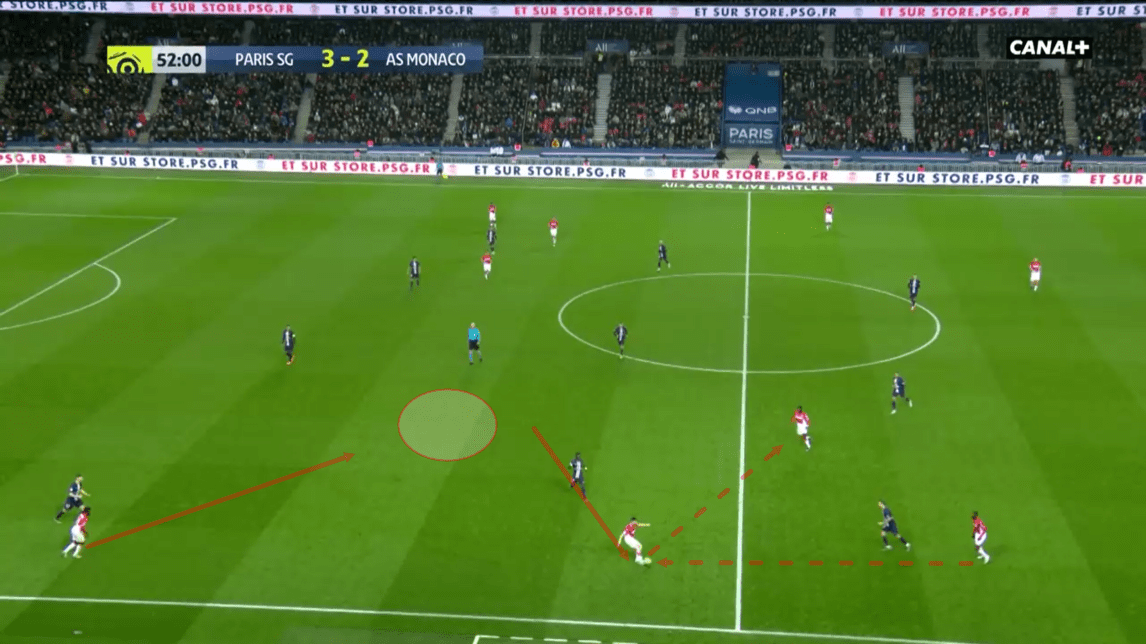
This image above is captured from Moreno’s second game in charge of Monaco. This shows us an example of Monaco already beginning to display some of the positional fluidity of Moreno’s tactics.
Here, we can see Monaco’s ‘8’, Aleksandr Golovin, just receive the ball from left-back Fodé Ballo-Touré. Golovin vacates his central position in order to receive the pass. In doing so, he creates space for current left-winger Keita Baldé Diao to move into.
Golovin plays a quick pass into central midfielder Tiémoué Bakayoko. As Diao moves into the central space, his movement creates a new angle for Bakayoko to advance the ball to.
Moreno’s use of positional fluidity helps his teams to keep possession and be positive and creative with the ball. We are already seeing this element of his coaching begin to appear at Monaco, and we are likely to see more of this as his time at Monaco goes on.
Overlapping full-backs
One key element to Moreno’s tactics with Spain was his frequent use of overlapping full-backs. Moreno liked to play his full-backs very high up the pitch with Spain. As the Spain coach, a large part of his job would have been to help his side prepare to break down deep-blocks. His use of full-backs, combined with off-the-ball movement of others, played a key role in helping his side do this.
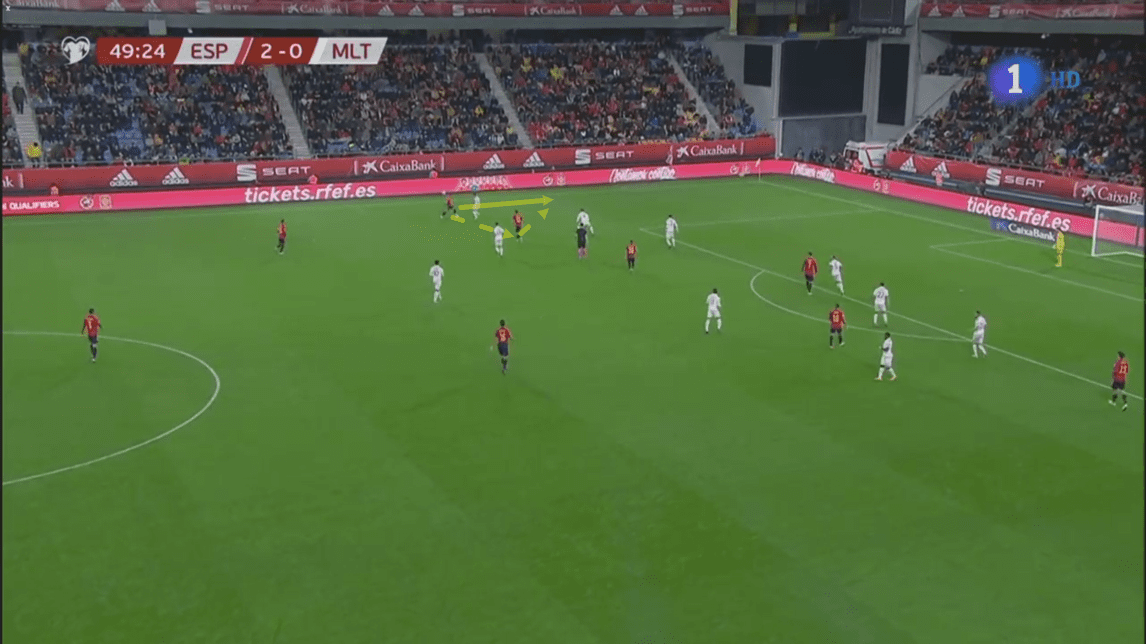
This image shows us an example of Moreno’s attacking full-backs. Here we can see Juan Bernat in possession of the ball as he is seen linking up with left-winger Sarabia in this image. Bernat occupies a wider area than Sarabia here. Meanwhile, Sarabia still presents a wide link-up option for Bernat.
The left-sided pair essentially create a 2 v 1 situation versus Malta’s right-back. They link up to play a quick 1-2 and Bernat is played through Malta’s defensive line. He subsequently plays a dangerous cross into the box for Malta’s central defenders to deal with.
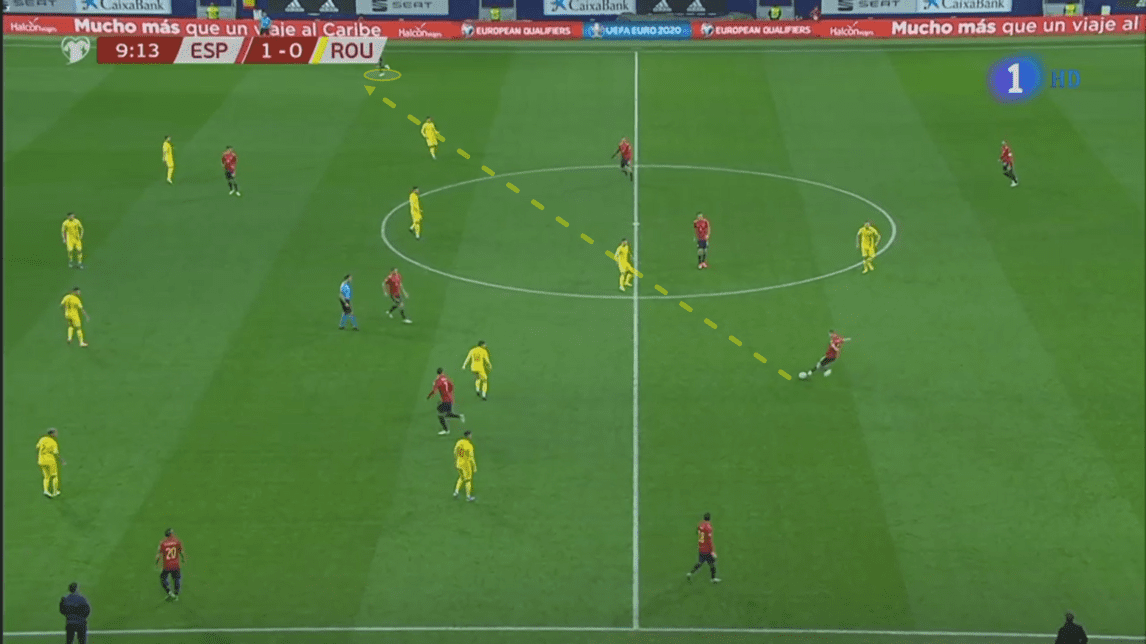
This second image shows us another example of Spain’s use of overlapping full-backs under Moreno. In this image, we can see how the overlapping run of Dani Carvajal, behind the scoreboard, helps his side to quickly progress the ball from the defence during the build-up into more threatening areas.
Iñigo Martínez does well to spot the run of Carvajal into space. Romania’s compact defensive block doesn’t allow Spain much space to play through the lines, however, they leave plenty of space out wide for Carvajal to exploit.
As he does so, Martínez picks him out and this helps Spain drive Romania back into a deeper area. Spain are then able to play their game of moving the Romanian defence about waiting for an opening.
This cross-field ball from the centre-back to the overlapping full-back was a very common feature of Moreno’s Spain. Opposition defences struggled to guard against this ball without allowing Spain space centrally. As a result, this ball became a very common sight in Spanish games. We expect to see Monaco increasingly utilise this kind of pass as they go on to face more defensive-minded teams.
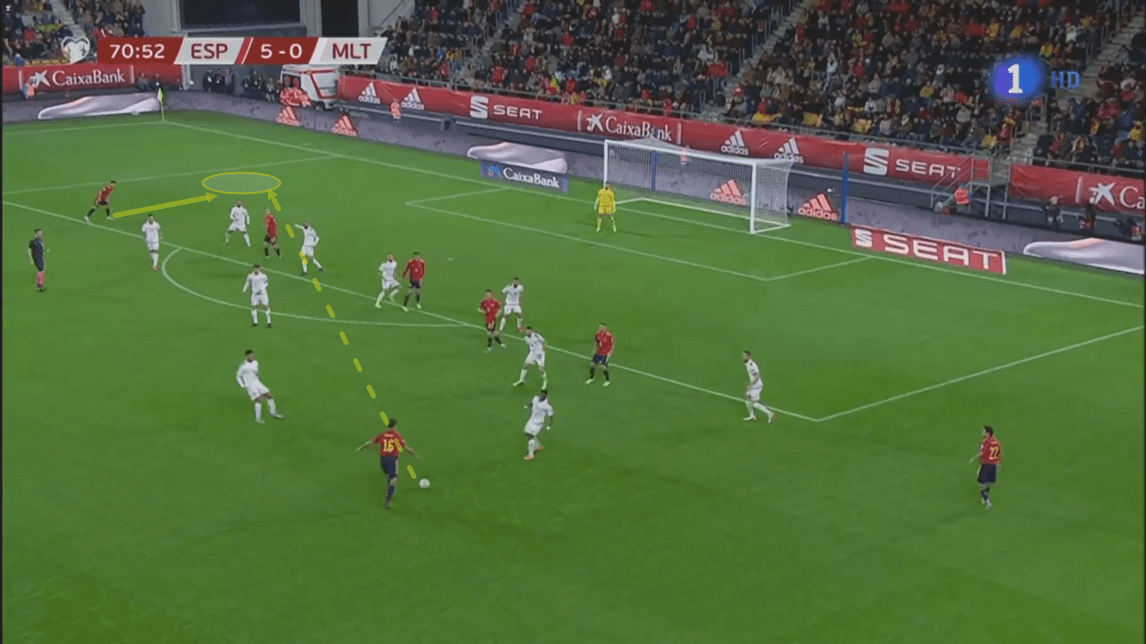
This image shows us how a similar type of cross-field ball to the one seen above can be dangerous when used higher up the pitch. In this image, we can see Rodri lining up a ball to the overlapping Bernat. We can see that Malta’s deep block is allowing Spain very little space between the lines here. However, Bernat’s run outside of Malta’s defence provides Spain with a quick solution to this problem.
Rodri plays an elegant ball to the overlapping Bernat who manages to lay the ball across the box first-time. The ball subsequently falls to Gerard Moreno (no relation) who taps it into an open net.
Spain were creative and dangerous with their use of overlapping full-backs under Moreno. This tactic was an effective one for them to progress the ball, as well as to directly create clear-cut chances. We expect to see Monaco increasingly utilise similar tactics as time goes on.
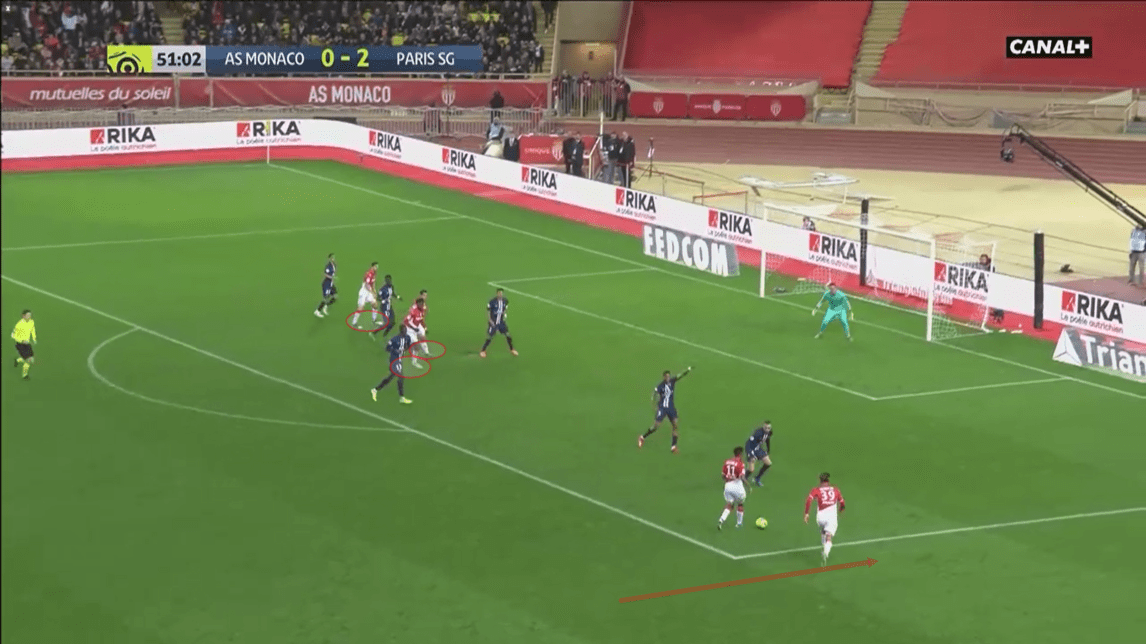
Moreno’s two Ligue 1 games versus PSG saw far fewer examples of overlapping full-backs. This was a consequence of the attacking quality of PSG, along with Moreno’s choice of midfielders at Monaco. However, we have seen glimpses of this tactic in action already at Monaco, as the image above shows us one of these examples.
Here, we can see Gelson Martins, now being deployed back at right wing under Moreno, on the ball. Meanwhile, Benjamin Henrichs, enjoying a more important role under Moreno, is seen overlapping. Note Monaco’s three central men here, another common theme of Moreno’s tactics which we will discuss later.
Monaco’s full-backs rarely ventured forward in either of the two recent games versus PSG. This was in order to create balance in their shape, to guard against the counter-attacking danger of PSG’s ‘fantastic four’. However, as we can see here, they did overlap at times.
On occasions when the full-backs overlapped versus PSG, a Monaco ‘8’ was forced to sit back alongside Bakayoko. At times, though, it was worth it as Monaco’s full-backs added a different element to the attack.
In the first game versus PSG however, Monaco lost their defensive balance occasionally. Henrichs, in particular, occasionally ventured forward while none of Monaco’s midfielders dropped back. This created an imbalance in Monaco’s shape which PSG punished.
At times, this imbalance forced Martins to track back as PSG countered. On two of these occasions over the two games, this resulted in PSG taking on Martins and earning a penalty. On other occasions, PSG were able to play Kylian Mbappé or Neymar through down the wing, whose pace caused problems for Monaco’s undermanned defence.
This imbalance to Monaco’s shape was often quickly amended afterwards and was met with less overlapping from the full-backs. As time goes on, we will see if this aspect of Moreno’s tactics is improved upon in big games such as this one versus PSG. It may just be teething problems as Monaco and Moreno get settled in.
However, it’s not beyond the realms of possibility that this could be a bit of tactical naivety from Moreno coming from his time with Spain where he could afford to commit more men forward more frequently. Versus weaker sides than PSG, Monaco could continue to deploy these aggressive tactics effectively. However, they undoubtedly caused defensive frailties versus PSG.
Moreno’s narrow central attacking three
As we briefly touched on above, Moreno likes to have three players occupying central zones in attack. The exact player(s) joining the centre-forward(s) in the central zones changes throughout the game. This is, maybe, another aspect of Moreno’s positional fluidity in that a variety of players can end up playing in a central attacking area. However, the three central bodies remains a constant feature of Moreno’s tactics.
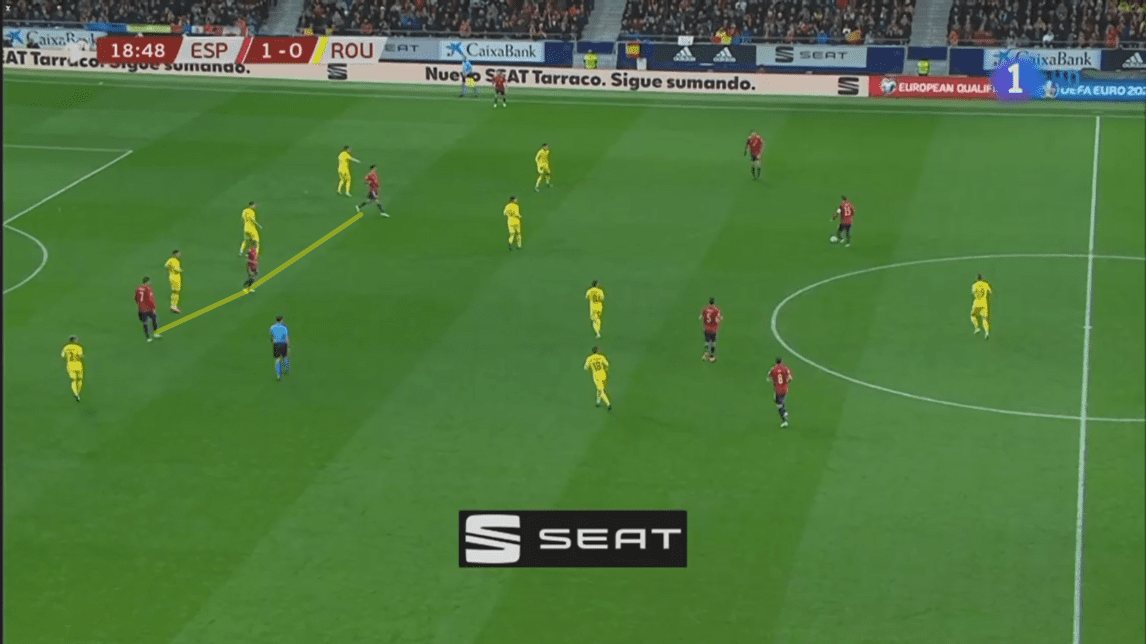
This image above shows us an example of Moreno’s deployment of three central attackers with Spain. Here we can see Cazorla joining Morata and Gerard Moreno in the central attacking zones.
The three central attackers decision is effective at providing a lot of options for Spain in attack. Furthermore, playing three men this central inevitably creates space in other areas. Here, we can see that the three central players are occupying the Romanian back four. The attackers’ positioning keeps the back four narrow and prevents the full-backs from closing down the wide attackers when they receive the ball.
The use of the three central attackers is effective at creating the space necessary for Spain’s overlapping full-backs to charge into. As a result, Moreno’s narrow central three help their side to progress the ball up the pitch simply through their positioning.
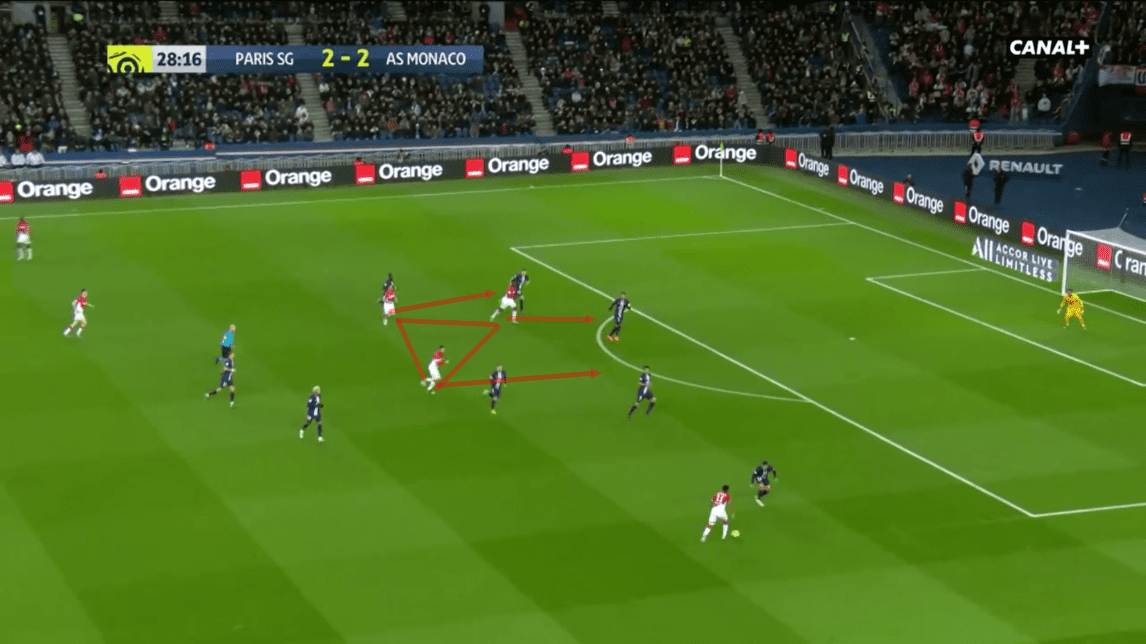
This image above shows us an example of Moreno’s central three attackers with Monaco. Here, we can see Wissam Ben Yedder, Diao, and Fabregas forming the central three. The positioning of these three attackers allows Martins to enjoy a degree of freedom on the right-wing. He is able to take Bernat on one-on-one here.
Meanwhile, the central three also creates space for a Monaco attacker to probe into on the left wing. However, on this occasion, this option is not capitalised on.
We can see this central attacking three continuing to play a key role in the tactics of Moreno’s Monaco moving forward. These tactics are effective at creating space in wide areas for the side in-possession. Given Moreno’s fondness for overlapping full-backs, this can be a useful tactic for getting them involved.
Moreno’s use of pressing
Last but not least, we are going to discuss Moreno’s use of pressing. This was a constant and key element of Moreno’s tactics during his time in charge of Spain. Moreno’s Spain pressed aggressively in order to win back possession quickly, in dangerous areas. Their quality and effectiveness in the press was effective at helping them to prevent their opposition from building out from the back at all.
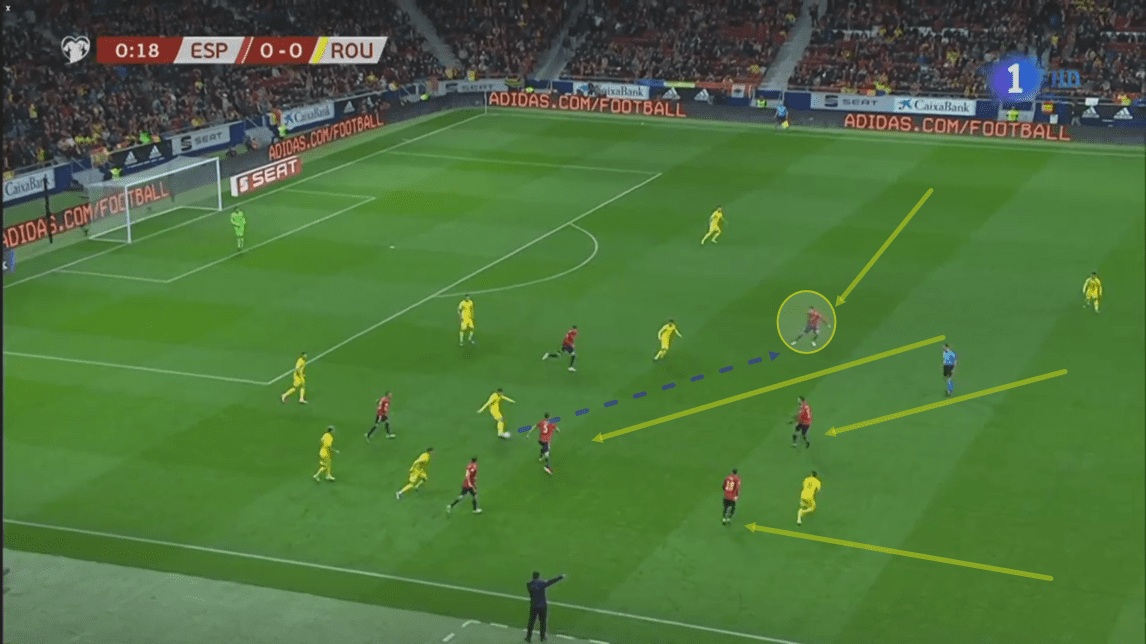
This image above shows us an example of Moreno’s Spain pressing high up the pitch, captured immediately after a Romanian kick-off at the beginning of the match. Romania play the ball back to their centre-back, however, Spain’s press forces the ball out to the right-back.
The pass to the Romanian right-back is what really triggers Spain’s press. The Spanish players begin to aggressively flock in numbers to their left-wing in order to cut off Romania’s passing options. We can see seven Spanish players on their left-wing in this image – all except for the two centre-backs and the right-back aggressively joined this press.
On this occasion, the aggressive Spanish press pays dividends as the right-winger Moreno, circled here, manages to intercept the pass being played in this image. This press was effective at quickly winning the ball back for Spain in a very dangerous position.
Aggressive pressing was a frequent feature of Moreno’s Spain tactics. They generally opted to win the ball high up the pitch. As a result of their press and their quality on the ball, Moreno’s Spain generally dominated possession.
Moreno’s defensive tactics with Monaco versus PSG generally differed greatly from his aggressive press with Spain. As a consequence of PSG’s undeniable quality, Moreno’s Monaco played far more passively out of possession versus PSG than Moreno’s Spain had played.
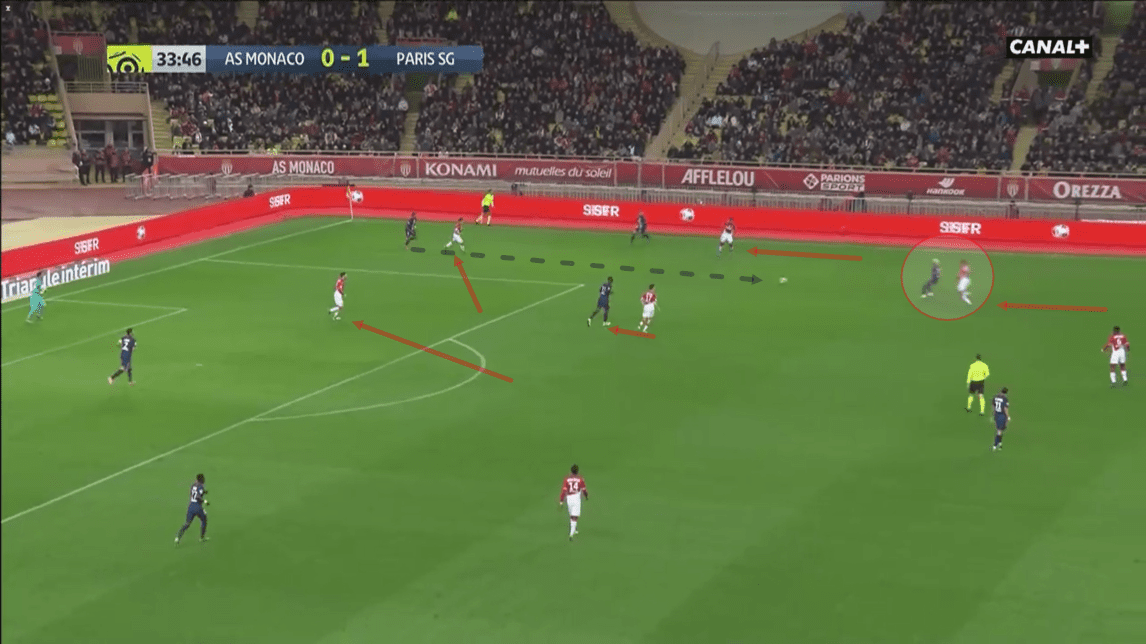
However, as we can see in this image above, they did occasionally press PSG quite aggressively at times over these two recent games. Monaco evidently pressed PSG high in their home game once they went 1-0 down, as we see here.
In the game at Le Parc des Princes, Monaco could effectively defend more passively and win the ball back in their own half – this was a result of PSG’s impatient attacking tactics. However, PSG learned from their mistakes for the follow-up game a few days later and as a result, they effectively played much more patiently.
PSG’s opening goal, combined with their more patient approach, forced Monaco to defend more aggressively. We can see this in the image above, as Monaco began to defend more aggressively around the half-hour mark.
Again, the pass to PSG’s full-back was the real trigger for Monaco’s press. We can see five Monaco shirts on their right wing here creating an overload. This was effective at preventing PSG from playing the ball out of their own half.
On this specific occasion, Neymar, dropping to receive the ball, manages to win a free-kick. However, Monaco’s switch to a more aggressive press helped them to get themselves more into this game at home versus PSG.
We expect to see this become an important feature of Moreno’s Monaco. We expect to see Monaco defend much more aggressively as they begin to face weaker sides than PSG.
Conclusion
To conclude this tactical analysis, it’s clear that Robert Moreno has shown a lot of tactically interesting ideas throughout his tenure with Spain that Monaco fans can be positive about moving forward. If Moreno’s Spain tenure and ‘Barcelona education’ are anything to go by, he’ll bring an exciting, possession-based style to Monaco.
Moreno appears to like his sides to dominate possession. However, his chance creation features a heavy amount of direct, cross-field balls as discussed above. Furthermore, he likes to utilise overlapping full-backs to exploit space versus compact blocks. These two elements frequently combine in the build-up to quickly progress play.
Moreno’s teams appear to deploy a large degree of positional fluidity which helps his side circulate possession. We expect to see more of this from Monaco as time goes on and it is another element of his play which greatly enables chance creation. We expect Moreno’s Monaco to develop into an extremely exciting and creative side.





Comments